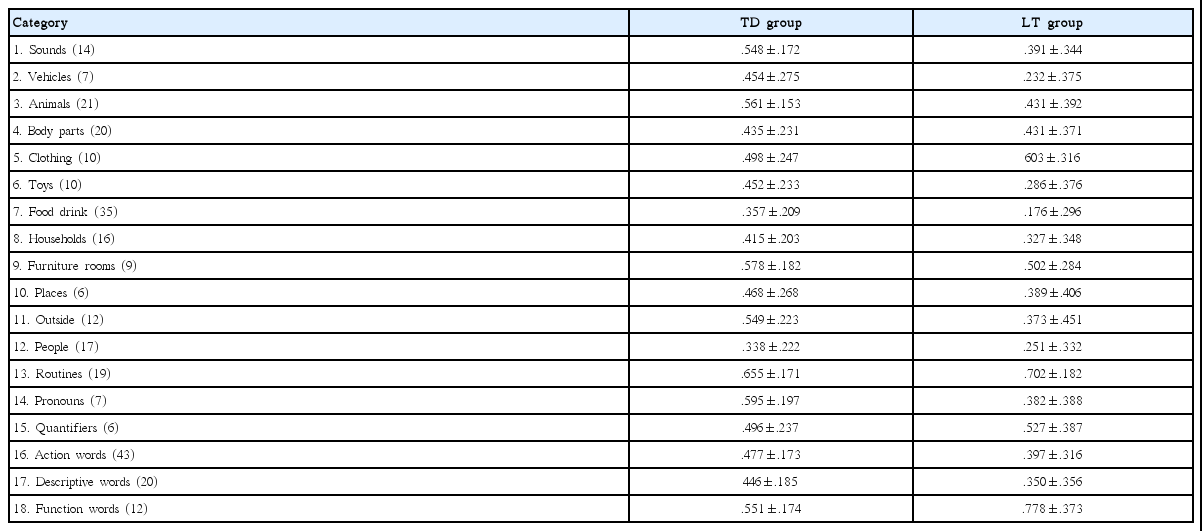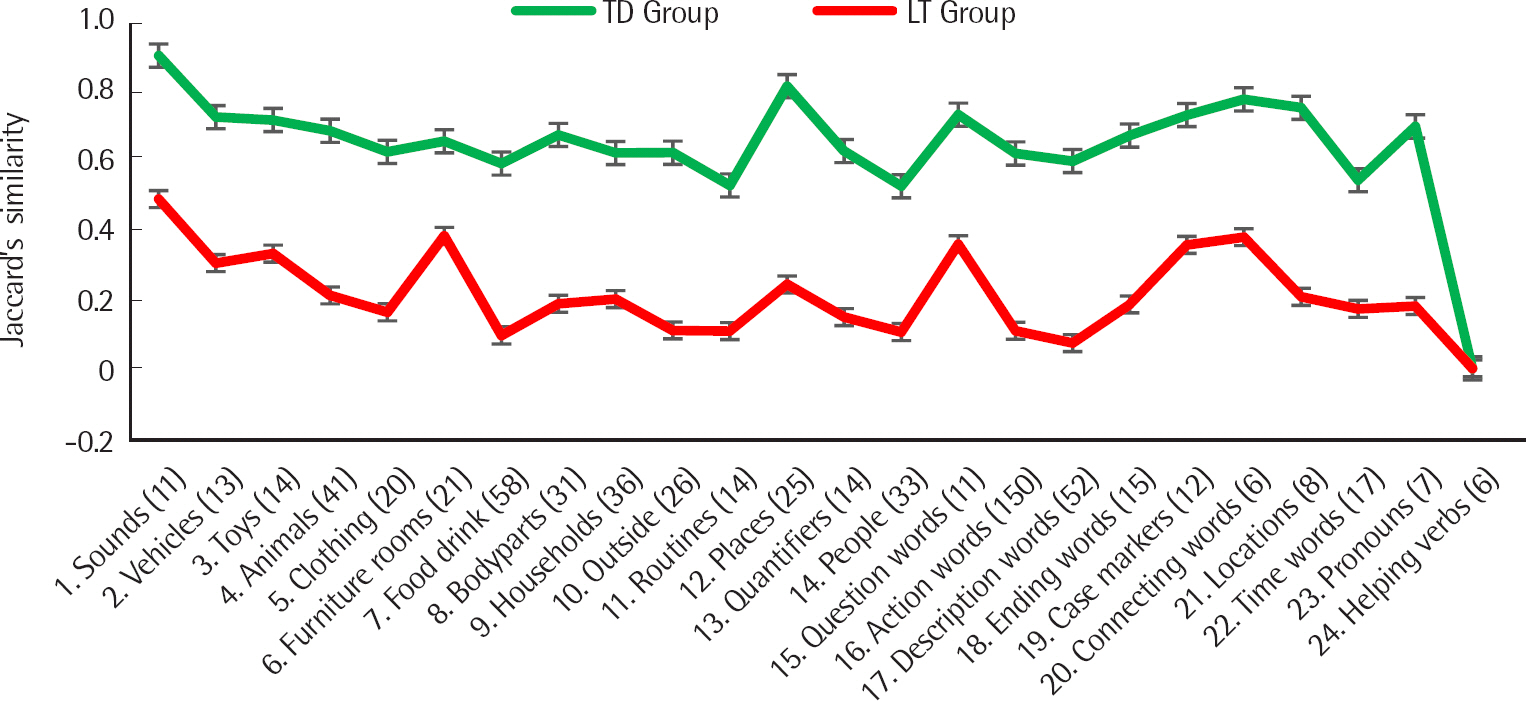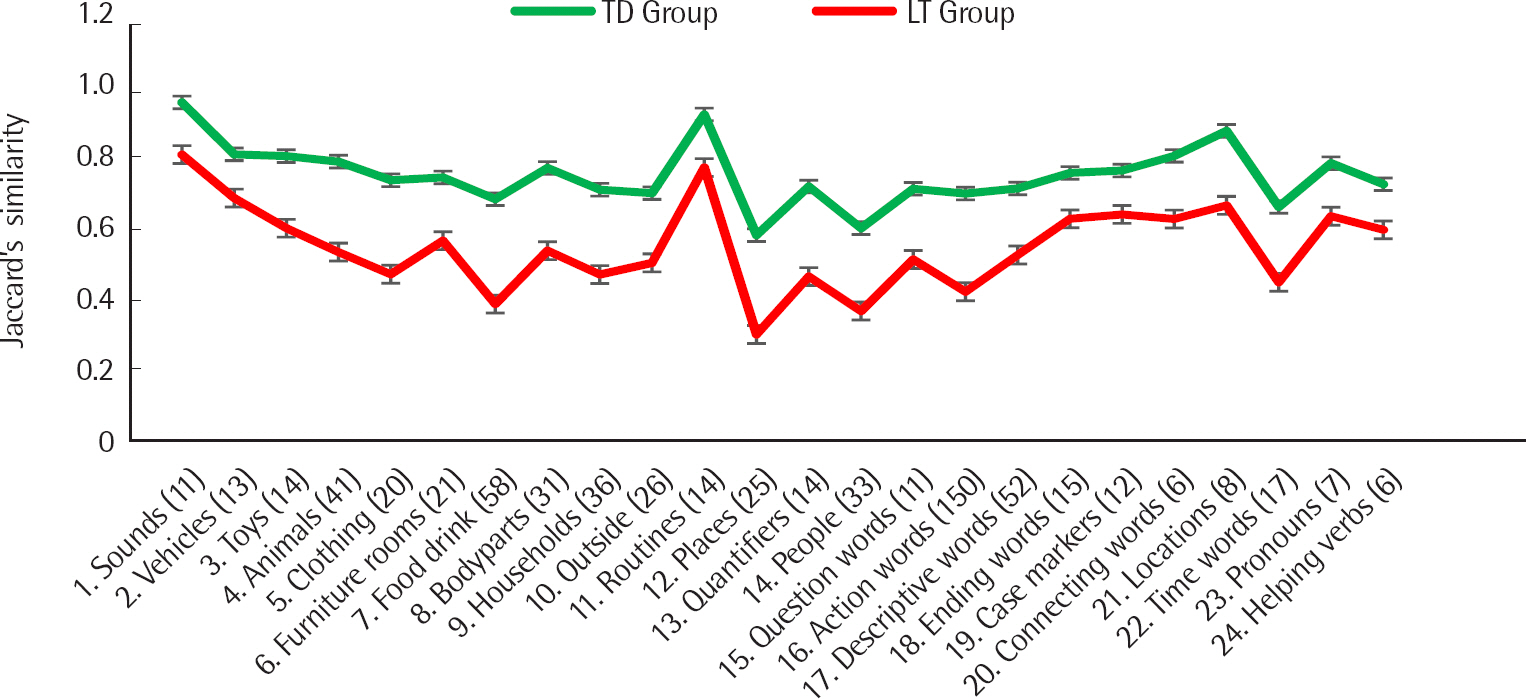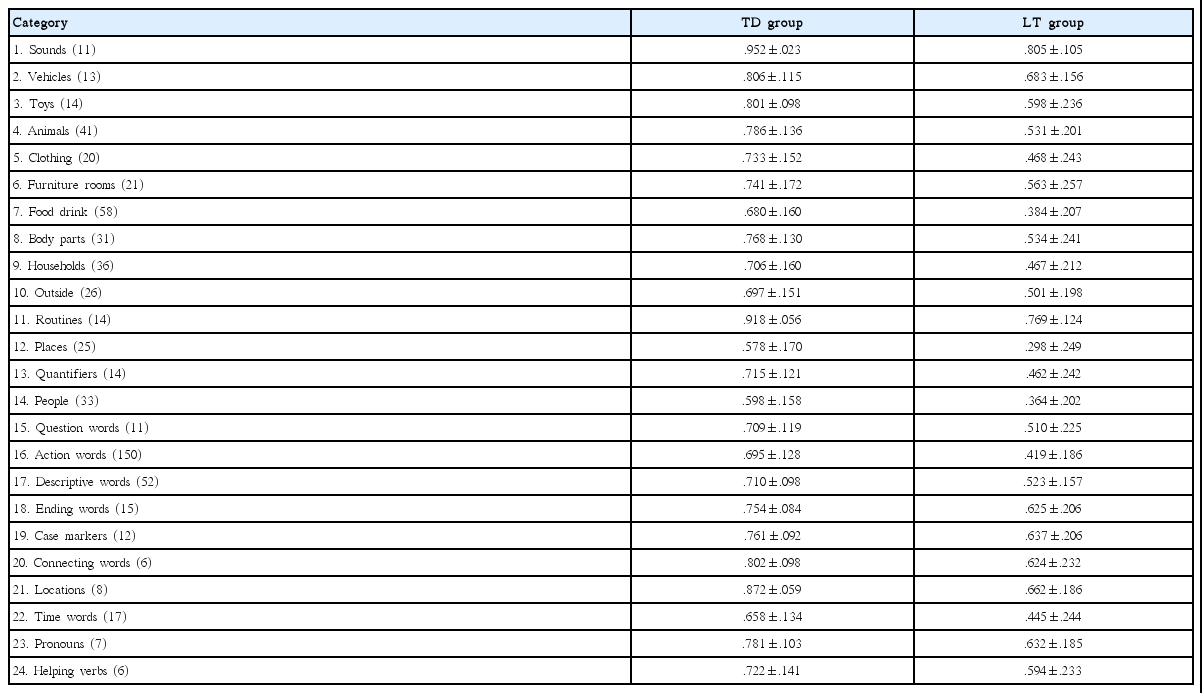말늦은 아동과 일반아동 간의 의미 연결성의 차이
Differences of Early Semantic Relatedness between Late Talkers and Typically Developing Children
Article information
Abstract
배경 및 목적
말늦은 아동에 대한 후속 연구는 말늦은 아동에게 잔존하는 언어적 결손이 있다는 것을 제시하였다. 본 연구는 말늦은 아동의 이러한 언어적 결손이 어휘 개념의 저장된 형태에서 온 것이라고 보고, 말늦은 아동 그룹과 일반아동 그룹 간의 의미 연결성의 차이를 설명하고자 한다.
방법
영아 55명 중 7명, 유아 169명 중 24명이 말늦은 아동으로 평가되었다. 말늦은 아동 그룹과 일반아동 그룹 간의 표현어휘와 이해어휘의 유사도의 차이를 일원배치분산분석(one-way ANOVA)을 통해 비교하였다.
결과
범주별로 비교하였을 때, 영아 이해어휘는 18개의 범주 중 13개의 범주에서 유의미한 차이를 보였다. 유아의 경우 표현어휘와 이해어휘 모두 일반아동과 말늦은 아동 간 유의미한 차이를 보였다. 범주를 제거한 단어의 유사성 비교에서도 세 비교군 모두 유의미한 차이를 보였다.
논의 및 결론
본 연구에서 말늦은 아동의 잔존하는 언어적 결함이 의미적 연결성에서 보여진다는 것을 확인하였으며, 복잡한 의미적 연결성이 어휘의 이해와 표현 모두에서 정의 상관관계를 보인다는 것을 알 수 있다. 이를 통해 고위험군(at risk)에 있는 영유아의 언어중재의 중요성을 시사하는 바이다.
Trans Abstract
Objectives
Previous studies on late talkers (LT) suggested that residual linguistic deficits would remain in these children as they advance through the higher grades in school. This study investigated whether the residual linguistic deficits of LT exist from the infant and toddler stage by manifesting the differences of semantic relatedness between typically developing children (TD) and LT.
Methods
Two hundred twenty-four reports of Korean Ma-cArthur-Bates Communicative Development Inventories were used to investigate the semantic relatedness of infants and toddlers aged from 8 to 36 months. Semantic relatedness was measured by Jaccard’s Index. After measuring the similarity of each group, one-way ANOVAs were conducted to investigate whether there were group differences. Three pairs of comparisons were made: infants’ comprehension, toddlers’ expression, and toddlers’ comprehension. Infants’ expression comparison was not conducted due to zero-expressive-words.
Results
The differences between LT and TD infants were significant within the lexical categories in comprehension, except for 5 categories out of 18: ‘Body parts,’ ‘Households,’ ‘Furniture and rooms,’ ‘Places,’ and ‘Quantifiers’. For toddlers, there was significant difference in every lexical semantic category both in expression and comprehension. All three pairs of comparison showed significant difference without categories.
Conclusion
The current study results suggest that semantic relatedness is the key factor in word learning during infancy and that weak semantic relatedness in early age could lead to remaining linguistic residual deficits. Study results are discussed in regard to early intervention of ‘at risk’ children and suggest the direction of intervention for late talkers.
A language is a communication tool and a complex system for representing knowledge and thoughts. For successful communication, a speaker should select and produce appropriate words. When they select words to produce, a concept should be formed before the speech is made. Levelt (1989, 1991) explained the process of word speech as involving three steps: conceptualizer, formulator, and articulator. Since conceptualization and formulation should be preceded by a word phonetically produced, how the concepts are formed and related each other is critical for successful speech production.
The lexical retrieval process, which belongs to the formulator stage in Levelt’ s model, is also important because asymmetry ex-ists between comprehension and production of early aged children. Early in development, children comprehend many more words than they produce. This is why those two tasks require different demands on retrieval processes (Gershkoff-Stowe & Hahn, 2007). Greater activation strengths are required to retrieve a word for producing than for comprehending a word (Capone & McGregor, 2005).
However, little is known about the lexical retrieval processes of very young children. For comprehension, the listener responds to an auditory cue, and then the phonological representation previously stored in memory is activated. Finally, the activation spreads from the phonological level to the semantic level where the word is comprehended (Gershkoff-Stowe & Hahn, 2007). The retrieval of a word for production, however, is processed by the reverse flow. Its initial activation is derived from non-linguistic cues. Gersh-koff-Stowe & Hahn (2007) explained that “ these cues originates in semantic memory and spreads to the phonological level, and then to be accessed for production with sufficient strength” (p. 683). Either way, improvements in children’ s ability to access stored representation in comprehension would support children’ s comprehension ability which lead to generating the associated words.
There are several factors which influence this lexical retrieval access. Dell (1990) suggested that highly frequent words are processed faster. This can be explained by the fast mapping effect, the ability to learn and retain new words with only minimal exposure (Carey & Bartlett, 1978; Heibeck & Markman, 1987). Not only word frequency, but neighborhood density also affects the lexical retrieval access (Gershkoff-Stowe & Hahn, 2007).
Neighborhood density in lexical retrieval access can be divided into two sectors. One is phonological neighborhoods, and the other is semantic similarity. According to many studies of adults’ speech, lexical access is facilitated more by phonetically similar words than sparsely phonetically similar words (Harley & Bown, 1998). Levelt (1989) mentioned that words are also connected to other words at the semantic level. This semantic similarity is another potential in early word learning, when early-aged children acquire new words (Baldwin, 1992; Gershkoff-Stowe, Connell, & Smith, 2006; Smith & Yu, 2008).
Language develops continuously from the moment of being born, but each child has different language ability depending on their intrinsic capacities, environments, personalities, etc. Once an infant acquires a word, he starts to learn other words very fast, we call this phenomenon vocabulary burst (Bates et al., 1994). However, there are infants who do not show vocabulary burst or speak late. Late talkers have definite delays in language acquisition, as opposed to development in other areas (Robertson & Ellis Weismer, 1999).
Follow-up investigations of late talkers has proved the urgent necessity of intervention for late talkers. According to Robertson and Ellis Weismer (1999), “ the majority of children meet normative expectation on language assessment measures and measures of early reading skills by the elementary school-age period (Paul, 1996; Rescorla, Hadicke-Wiley, & Escarce, 1993), however they acquired significantly lower scores than control groups in various areas of linguistic functioning (Paul, 1996; Rescorla et al., 1993)” (p. 1235). Robertson and Ellis Weismer (1999) also supported the argument that “ residual linguistic deficits” (p. 1235) would remain in these children as they advance through the higher grades in school.
This study thoroughly reviews the differences of semantic similarity between the typically developing children’ s group (TD) and the late talkers group (LT). Studies have been conducted to measure the semantic relatedness among words, including feature similarity, and co-occurrence (Mirman & Magnuson, 2006). This study would also focus on the early semantic relatedness of infants and toddlers to verify the residual deficits of LT. The current Research tries to verify the differences of words’ relatedness between TD and LT by counting co-occurrence data in Korean MacAr-thur-Bates Communicative Development Inventories (KM-BCDI; Pae & Kwak, 2011) based on Jaccard’ s Similarity Index. Based on the semantic similarity, this study ultimately aims to compare semantic networks in each group and to investigate whether the features are same across two groups. Moreover, this study would analyze not only expressive vocabulary but also comprehensive words of children. Therefore, there would be 8 sectors: infants’ TD expression, infants’ TD comprehension, infants’ LT expression, infants’ LT comprehension, toddlers’ TD expression, toddlers’ TD comprehension, toddlers’ LT expression, and Toddlers’ LT comprehension.
First, the semantic relatedness of each word within lexical-se-mantic categories would be compared in each category. Secondly, the semantic relatedness of each word without lexical semantic categories would be examined. Finally, the visualization of the semantic network would be presented to compare two groups more easily.
METHODS
Participants
A total of 224 participants (55 infants and 169 toddlers) were assessed using the K M-B CDI (Pae & Kwak, 2011). The K M-B CDI reports consists of two types: ‘ words and gestures’ and ‘ words and sentences’. Words and gestures are for infants from 8 to 17 months; words and sentences are for toddlers whose ages are from 18 months to 36 months.
Out of 224 reports, 196 reports were from the Wordbank database (http://wordbank.stanford.edu/). Thirty-eight participants were additionally recruited from daycare centers in Seoul, Seong-nam, and Pusan in Korea. Among 224 participants, 31 were assessed as late talkers (7 were infants, and 24 were toddlers).
Participants were selected who meet the following criteria: (1) must have been born in Korea, (2) must use Korean at home with Korean speaking parents, and (3) must exhibit normal hearing and neurological development. The above information was collected through the Alberta Language Development Parent questionnaire (ALDeQ; Paradis, Emmerzael, & Duncan, 2010). Table 1 shows the descriptive statistics of participants’ characteristics— number of participants, gender, age, and KM-BCDI score in expressive and comprehensive vocabularies.
The mean age for TD toddlers was 27±6 months, for LT toddlers was 23±4 months, for TD infants was 13±2 months, for LT infants was 12±2 months.
A set of one-way ANOVAs were conducted to investigate if there were group differences. There was no significant group difference in age in months, for both infants (F(1, 53) =.452, p>.001) and toddlers (F(1, 167) = 7.260, p>.001). There was no significant group difference in infants’ scores of KM-BCDI as well, for both expression (F(1, 53) = 6.306, p>.001) and comprehension (F(1, 53) =.676, p>.001). However, there was significant group difference in toddlers’ scores of K M-B CDI, for both expression (F(1, 167) = 64.798, p < .001) and comprehension (F(1, 167) = 26.488, p < .001).
This comparison of average scores evidently shows the necessity of more sophisticated methods to assess infants and toddlers. In the period of infants and toddlers, they show cascading language development. The difference between words production may not seem serious in early age but it distinguishes LT from TD, and the difference remains.
Measures
MacArthur-Bates Communicative Development Inventories
MacArthur-Bates Communicative Development Inventories (MBC-DI; Dale & Fenson, 1996) is a widely-used assessment tool for assessing language development of infants and toddlers. Parents report which words their children produce on a checklist organized by lexical-semantic categories (Braginsky, Yurovsky, Marchman, & Frank, 2015). Pae & Kawk (2011) issued a Korean version of MBCDI, K M-B CDI.
Parental questionnaire: Alberta Language and Development Questionnaire
The ALDeQ (Paradis et al., 2010) was used to evaluate and check the overall developments of the participants based on the parental reports. This tool can be used for children who are not limited in language and cultural environment, and it is useful for screening children with language impairment (Restrepo, 1998). The questionnaire consisted of four parts: early milestone, current abilities in the first language, behavior patterns and activity preferences, and family history. Through these questionnaires, it was confirmed that participants met the criteria for this study.
Data Scoring
Parents were asked to check both comprehension and expression lists, and researchers double- checked those reports. If one expresses a word for example “ kkokkio”, 1 was put, and if one does not express the word, 0 was put. The scores of comprehension and expression were separately inputted for each word. The lexical semantic categories were divided as K M-B CDI. One example of data arrangement is shown in Table 2.
After putting all answers to each word, the similarity was measured by the Jaccard similarity measure. When variables are bina-ry, co-occurrences are measured by the Jaccard coefficient similarity (Borg & Groenen, 2003). Jaccard’ s Index is measured by the following formulation.
In this study, Jaccard’ s coefficient was measured through SPSS version 22.0 for Windows, both words within lexical-semantic category and words without categories were measured.
Data Analysis
The statistical analyses were conducted using SPSS version 22.0 for Windows as well. First, Jaccard’ s coefficient was measured with absolute values. Three sets of one-way ANOVAs were conducted to compare group scores for similarity.
RESULTS
Group Differences in Similarity within Lexical-Semantic Categories
One hundred sixty-eight matrices were abstracted. The K M-B CDI for toddlers (words and sentences) has 24 semantic categories, therefore, 24 matrices for TD toddlers’ expression and comprehension, respectively, and for LT toddlers as well. The K M-B CDI for infants (words and gestures) has 18 categories, therefore, 18 matrices for TD infants’ expression and comprehension, respec-tively, and for LT infants as well. Since LT infants do not express even a single word, the comparison on similarities of infants’ expression was not possible. Therefore the comparison of infants’ expression was not conducted.
One example of similarity matrix is shown in Table 3.
The descriptive statistics of the average similarity of infants’ comprehension are provided in Table 4.
To compare the difference of similarity of infants’ comprehension between TD and LT on each lexical semantic category, a one-way ANOVA was conducted with ‘ group’ as the within-subjects factor.
Fifteen categories out of eighteen were significantly different (p < .001) between those two groups listed above. In 5 categories, which included ‘ Body parts’, ‘ Households’, ‘ Furniture and rooms’, ‘ Places’, and ‘ Quantifiers’, the differences were not significant.
The group differences of similarity of infants’ comprehension between TD and LT group in each lexical category are shown in Figure 1.
The descriptive statistics of the mean similarity of toddlers’ expression are provided in Table 5.
To compare the difference of similarity of the toddlers’ expression between the TD and LT group on each lexical semantic category, a one-way ANOVA was conducted with ‘ group’ as the with-in-subjects factor. Twenty-three categories out of 24 were significantly different (p < .001) between those two groups listed above. The mean difference of similarity in ‘ Helping verbs’ category does not exist, for the expression scores were all 0 for LT group. The group differences of similarity of toddlers’ expression between TD and LT group in each lexical category are shown in Figure 2.
The descriptive statistics of the average similarity of toddlers’ comprehension are provided in Table 7.
To compare the difference of similarity of toddlers’ comprehension between the TD and LT group on each lexical semantic category, a one-way ANOVA was conducted with ‘ group’ as the with-in-subjects factor. Twenty-four categories out of 24 were significantly different (p < .001) between those two groups listed above. The group differences of similarity of toddlers’ comprehension between TD and LT group in each lexical category are shown in Figure 3 and Table 6.
Group Differences in Similarity without Lexical- Semantic Categories in K M-B CDI
The similarities between words without lexical categories were measured. Six hundred and forty-one words for toddlers’ expression and comprehension, and 284 words for infants’ expression. As conducted within category, three pairs of ANOVAs, infants’ comprehension, toddlers’ expression, and toddlers’ comprehension, were conducted. Since the average score of LT infants’ expression is 0, the comparison of the similarity of infants’ expression was not possible.
The descriptive statistics of the average similarity of infants’ comprehension without lexical semantic categories are provided in Table 7.
To compare the difference of similarity of infants’ comprehension between TD group and LT group without lexical semantic category, a one-way ANOVA was conducted with ‘ group’ as the within-subjects factors.
Without lexical semantic categories, two groups were significantly different (p < .001) as listed above. The group differences of similarity of infants’ comprehension between TD and LT group without the lexical semantic category are shown in Figure 4.

Mean similarity of infants' comprehension without categories.
TD=typically developing children; LT=late talker
The descriptive statistics of the average similarity of toddlers’ expression without lexical semantic categories are provided in Table 7. Without lexical semantic categories, the two groups were significantly different (p < .001) as listed above. The group differences of similarity of toddlers’ expression between the TD and LT group without lexical semantic categories are shown in Figure 5.

Mean similarity of toddlers' expression without categories.
TD=typically developing children; LT=late talker.
The descriptive statistics of the average similarity of toddlers’ comprehension without lexical semantic categories are provided in Table 7.
To compare the difference of similarity of toddlers’ comprehension between the TD and LT group without lexical semantic category, a one-way ANOVA was conducted with ‘ group’ as the with-in-subjects factor. Without lexical semantic categories, the two groups were significantly different (p < .001) as listed above. The group differences of similarity of toddlers’ comprehension between TD and LT group without lexical semantic categories are shown in Figure 6.
CONCLUSION
Late talkers are assessed to have obvious delays in acquiring language, in contrast to development in other areas (Robertson & Ellis Weismer, 1999). Approximately half of the late talkers catch up with their peers by age three (Paul, 1991; Rescorla & Schwartz, 1990; Rescorla, Roberts, & Dahlsgaard, 1997). Even though they reach the normal range of linguistic ability during the elementary school-aged period, they receive significantly lower scores in language assessment than their peers in the higher grades in school (Paul, 1996; Rescorla et al., 1993). Paul, Hernandez, Taylor, & Johnson (1996) insisted that residual linguistic deficits would remain in these children as they advance through the higher grades in school.
This study hypothesized the residual deficits start from conceptualization stage. Out of theories on the representation of knowledge, this study is based on the Spreading activation model. The model is explained as a complex network of associations. Specific items are distributed in the conceptual space with related concepts, and the concepts are linked by associations (Solso, MacLin, & MacLin, 2008).
To examine the linkage of semantics, the current study compared the similarity of words between LT and TD. A total of 224 reports of K M-B CDI (Pae & Kwak, 2011) were used to investigate the semantic relatedness of infants and toddlers from 8 to 36 months of age. One hundred ninety-six reports were from Wordbank (http:// wordbank.stanford.edu/), and 38 reports were gathered by additional recruitment. K M-B CDI has two versions: one is for infants (8 to 17 months) and the other is for toddlers (18 to 36 months). Out of 224, 55 were infants, and 169 were toddlers. Among them, 7 infants were LT, and 24 toddlers were LT.
Semantic relatedness was measured by Jaccard’ s Index. After measuring the similarity of each group, one-way ANOVAs were conducted to investigate whether there were group differences. Three pairs of comparisons were made: infants’ comprehension, toddlers’ expression, and toddlers’ comprehension. Infants’ expression comparison was not conducted due to zero-expressive-words.
Differences of Semantic Relatedness within Categories
K M-B CDI (Pae & Kwak, 2011) has its lexical semantic categories. Words and gestures for infants have 18 lexical semantic categories, and words and sentences for toddlers has 24.
First, the mean similarity of infants’ comprehension was COMPAREd. The mean similarity of words in fifteen categories was significantly different. TD’ s mean similarity was higher than LT’ s. This indicates that relatedness of LT’ s is significantly weaker than TD’ s. The 5 categories which did not show significance were ‘ Body parts’, ‘ Households’, ‘ Furniture and rooms,’ ‘ Places’, and ‘ Quantifiers’.
Early vocabularies tend to consist of nouns while verbs and closed-class forms are typically acquired later (Bates et al., 1994). According to Hills, Maouene, Maouene, Sheya, & Smith (2009), the fact that “ early noun learning is slow at first and becomes fast” suggests that “ already learned nouns might help in learning new nouns” (p. 729). This means that both infants and toddlers should show their increased numbers of acquired words, once they learned how to speak a few words. However, the difference of semantic relatedness has become more significant as infants get older. Even though the comparison of a few categories did not show significant differences in infants’ comprehension, that all the categories of toddlers showed significant differences could give further evidence of residual deficits in late talkers.
Differences of Semantic Relatedness without Categories
All three pairs resulted in having significant differences in comparison without categories. The most outstanding difference was evident in toddlers’ expressive vocabulary, and the most obscure difference was observed in infants’ comprehension.
However, there were variables which were laid at the bottom in the infants’ comprehension graph. These variables were not dis-tinctively evident in the within categories comparison. These variables, laid at the bottom, could be the evidence of residual deficits which lead late talkers to linguistic delay. Those lowest similarity words (p < .004) in LT infants are arranged in Appendix 1.
Clinical Implications and Limitations
Approximately half of the late talkers catch up with their peers by age three, and these children are designated ‘ late bloomers’ (Paul, 1991; Rescorla & Schwartz, 1990; Rescorla et al., 1997). Even after vocabulary reaches the normal range, a number of late talkers continue to demonstrate production delays in other areas, including phonology, morphology, syntax and narrative abilities (Paul, 1991; Paul et al., 1996; Paul & Smith, 1993; Rescorla & Schwartz, 1990; Robertz, Rescorla, Giroux, & Stevens, 1998). Furthermore, follow-up study on late talkers has revealed that even though they reach the normal range of linguistic ability in the elementary school-aged period, they receive significant lower scores in language assessment than their peers in the higher grades in school. This suggests that there could be linguistic residual deficits in late talkers. The present study hypothesized that there are linguistic residual deficits in late talkers and tried to verify the evidence of residual deficits by comparing the similarity of TD and LT.
The idea of comparing the similarity of two groups is based on the Spreading Activation Model. The Spreading Activation Model explains semantic processing with the network model. According to the Spreading Activation Model, concepts which are related to each other activate stronger and faster. Collins & Loftus (1975) created this model, and they suggested that concepts are featured by nodes in a semantic network. Concepts which have a similar meaning are connected with each other within the network.
Early links between language and cognition provide the foundation for processing information (Ferguson & Waxman, 2017). A study of Smith & Yu (2008) provided that the link between language and categories is established early in infancy. Categorization is fundamental to word learning, which makes it easier to learn novel words (Chomsky, 2011).
The hypothesis of this study was that the residual deficits of LT came from the weak ability of semantic relatedness. In the semantic networks, links between words imply relatedness. Categorizing ability, which connects concepts towards languages, could be the reason for the linguistic residual deficits of LT. Both TD and LT showed lower similarity index in the comparison of without categories than within categories. The words laid in the bottom in the similarity graph (Figure 4) can also be the evidence of the weak categorizing ability of infants.
This study did not offer the learning mechanism of words via semantic networks. The small number of LT infants was a weak-ness in this study. Due to the small number of LT infant subjects, the results in some categories were distorted; such as ‘ Function words’, which showed higher similarity in LT than TD. Another limitation of this study is that the words inventory should not have been limited to the K M-B CDI. There could have been more words that LT could speak, but those words were not considered.
However, the current study proposed that semantic relatedness is a key factor in word learning in infancy and that weak semantic relatedness in early age could lead to remaining linguistic residual deficits. Therefore, this study can be the academic evidence for urging early intervention of ‘ at risk’ children and suggests the direction of intervention on late talkers.











